The influence of surface modified poly(l-lactic acid) films on the differentiation of human monocytes into macrophages†
Abstract
Macrophages play a crucial role in the biological performance of biomaterials, as key factors in defining the optimal inflammation-healing balance towards tissue regeneration and implant integration. Here, we investigate how different surface modifications performed on poly(L-lactic acid) (PLLA) films would influence the differentiation of human monocytes into macrophages. We tested PLLA films without modification, surface-modified by plasma treatment (pPLLA) or by combining plasma treatment with different coating materials, namely poly(L-lysine) and a series of proteins from the extracellular matrix: collagen I, fibronectin, vitronectin, laminin and albumin. While all the tested films are non-cytotoxic, differences in cell adhesion and morphology are observed. Monocyte-derived macrophages (MDM) present a more rounded shape in non-modified films, while a more elongated phenotype is observed containing filopodia-like and podosome-like structures in all modified films. No major differences are found for the expression of HLA-DR+/CD80+ and CD206+/CD163+ surface markers, as well as for the ability of MDM to phagocytize. Interestingly, MDM differentiated on pPLLA present the highest expression of MMP9. Upon differentiation, MDM in all surface modified films present lower amounts of IL-6 and IL-10 compared to non-modified films. After stimulating MDM with the potent pro-inflammatory agent LPS, pPLLA and poly(L-lysine) and fibronectin-modified films reveal a significant reduction in IL-6 secretion, while the opposite effect is observed with IL-10. Of note, in comparison to non-modified films, all surface modified films induce a significant reduction of the IL-6/IL-10 ratio, a valuable prognosticator of the pro- versus anti-inflammatory balance. These findings provide important insights into MDM–biomaterial interactions, while strengthening the need for designing immune-informed biomaterials.



 Please wait while we load your content...
Please wait while we load your content...